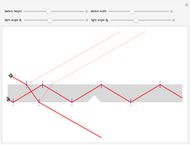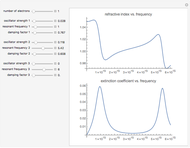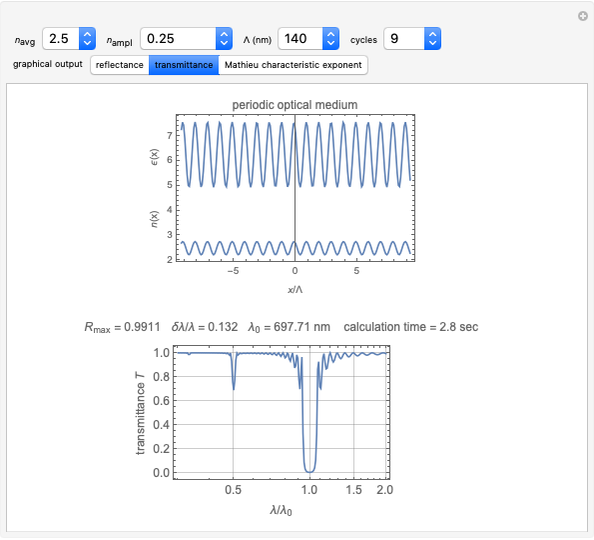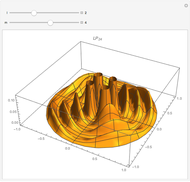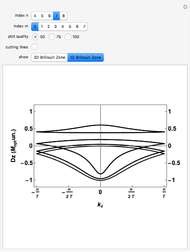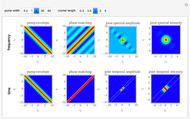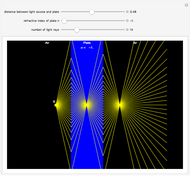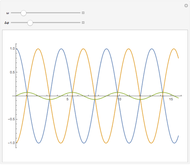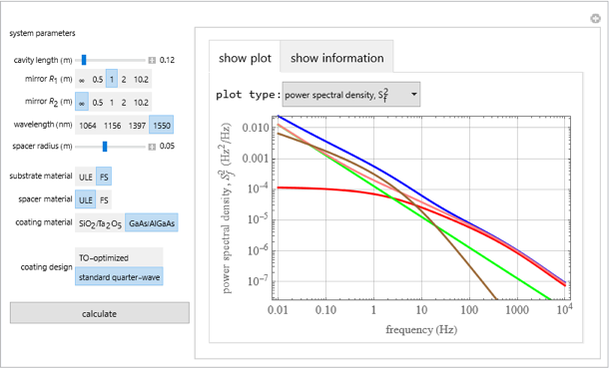Optical Cavity Noise for Crystalline and Amorphous Coatings

Requires a Wolfram Notebook System
Interact on desktop, mobile and cloud with the free Wolfram Player or other Wolfram Language products.
Contributed by: Garrett Cole, Seth B. Cataño Lopez, Michael Martin and Wei Zhang (August 27)
Open content licensed under CC BY-NC-SA
Details
An optical reference cavity is commonly employed to reduce the frequency (or phase) noise of a laser, leading to a significant reduction in the integrated linewidth and a corresponding improvement in the laser coherence time (or length). The ultimate noise floor in such a laser system will be determined by the noise in the reference cavity itself. With sufficient isolation, technical sources of noise can be neglected, and the fundamental noise limit will be given by the thermomechanical fluctuations of the constituent materials of the cavity [1]. These unavoidable perturbations in cavity length will be directly imparted onto the frequency noise of the locked laser system. State-of-the-art laser systems employing high-performance optical cavities are now capable of achieving line widths <10 mHz, with coherence times >15 s [2, 3], with the high-reflectivity optical coatings remaining the limiting aspect of the ultimate laser performance.
In this Demonstration, we calculate the fundamental noise contributions commonly considered for Fabry–Perot optical cavities. There a variety of design options you can choose from, with inputs being cavity length, mirror curvature, laser wavelength, spacer radius (cavity bore radius is kept constant at 5 mm), substrate and spacer material, plus coating materials. For the latter, two options are included: i) traditional ion-beam sputtered Ta2O5/SiO2 amorphous coatings [4] and ii) substrate-transferred GaAs/AlGaAs crystalline coatings [5]. This allows you to compare the performance of various cavity geometries and the impact of the mirror coatings on the overall cavity stability. As means to further improve such systems, in 2013, GaAs/AlGaAs-based crystalline coatings were demonstrated as a promising alternative to traditional amorphous coatings. These single-crystal structures yield a significant reduction in the coating Brownian noise contribution, stemming from the low elastic loss of these materials [5]. There are two design choices for the crystalline coating, a standard quarter-wave stack or a "TO-optimized" design, which illustrates the effect of using an aperiodic multilayer engineered for thermooptic noise minimization [6].
You can also choose to display the calculated cavity noise in a variety of different units (frequency, phase or displacement noise), as well as the resulting Allan deviation.
The noise contributions, in units of  /Hz considered in this notebook are the following [6]:
/Hz considered in this notebook are the following [6]:
The following noise contributions, in units of  /Hz, are considered [6]:
/Hz, are considered [6]:
Spacer Brownian noise:

Substrate Brownian noise:

Substrate thermoelastic noise:

Coating Brownian noise:

Coating thermooptic noise:



where the spectrum for thermal fluctuations is described by

 is a correction to account for the finite thickness of the coating (see [7] for more information). When the thickness of the coating becomes comparable to the thermal diffusion length in the coating, that is,
is a correction to account for the finite thickness of the coating (see [7] for more information). When the thickness of the coating becomes comparable to the thermal diffusion length in the coating, that is,  , where
, where  . For a GaAs/AlGaAs crystalline coating, this diffusion length is on the order of ~100 µm at 1 kHz, thus it is important to take this into account.
. For a GaAs/AlGaAs crystalline coating, this diffusion length is on the order of ~100 µm at 1 kHz, thus it is important to take this into account.
 and
and  are special functions that consider the low frequency response, which has a low pass filter response at the characteristic frequency
are special functions that consider the low frequency response, which has a low pass filter response at the characteristic frequency  . See [8] for further details.
. See [8] for further details.
It can be seen in the spectrum for coating thermooptic noise, that proper engineering of the average values  ,
,  ,
,  can lead to minimization of this noise contribution
can lead to minimization of this noise contribution  . When coating Brownian noise is greatly reduced, as in the case of crystalline coatings, thermooptic noise can dominate the noise spectrum at low frequencies. You can see how this noise contribution can be greatly reduced by selecting "coating design TO-optimized".
. When coating Brownian noise is greatly reduced, as in the case of crystalline coatings, thermooptic noise can dominate the noise spectrum at low frequencies. You can see how this noise contribution can be greatly reduced by selecting "coating design TO-optimized".
The physical constants and symbols in this Demonstration (s → substrate, sp → spacer, c → coating) include the following:
LSymbolUnitsDescriptionLmCavity LengthEPaYoung's modulusσ–Poisson's ratioCJK m3Heat capacity per unit volumeκWK mThermal conductivityα1KCoefficient of thermal expansionβ1KThermo-refractive coefficient&straightpi;—Elastic loss angleω1,2mLaser beam radius of mirror 1 or 2, defined as 1/e2 power decaydmCoating thicknesskbJKBoltzmann constantRmSpacer outer radiusrmCavity bore radiusfHzFrequencyλmLaser wavelengthColumnsRowsColumnsRows
References
[1] K. Numata, A. Kemery and J. Camp, "Thermal-Noise Limit in the Frequency Stabilization of Lasers with Rigid Cavities," Physical Review Letters, 93(25), 2004 250602. doi:10.1103/PhysRevLett.93.250602.
[2] D. Kedar, J. Yu, E. Oelker, A. Staron, W. R. Milner, J. M. Robinson, T. Legero, F. Riehle, U. Sterr and J. Ye, "Frequency Stability of Cryogenic Silicon Cavities with Semiconductor Crystalline Coatings," Optica, 10(4), 2023 pp. 464–470. doi:10.1364/OPTICA.479462.
[3] D. G. Matei, T. Legero, S. Häfner, C. Grebing, R. Weyrich, W. Zhang, L. Sonderhouse, J. M. Robinson, J. Ye, F. Riehle and U. Sterr, "1.5 µm Lasers with Sub-10 mHz Linewidth," Physical Review Letters, 118(26), 2017 263202. doi:10.1103/PhysRevLett.118.263202.
[4] G. M. Harry, A. M. Gretarsson, P. R. Saulson, S. E. Kittelberger, S. D. Penn, W. J. Startin, S. Rowan, M. M. Fejer, D. R. M. Crooks, G. Cagnoli, J. Hough and N. Nakagawa, "Thermal Noise in Interferometric Gravitational Wave Detectors Due to Dielectric Optical Coatings," Classical and Quantum Gravity, 19(5), 2002 pp. 897–917. doi:10.1088/0264-9381/19/5/305.
[5] G. D. Cole, W. Zhang, M. J. Martin, J. Ye and M. Aspelmeyer, "Tenfold Reduction of Brownian Noise in High-Reflectivity Optical Coatings," Nature Photonics, 7(8), 2013 pp. 644–650. doi:10.1038/nphoton.2013.174.
[6] T. Chalermsongsak, F. Seifert, E. D. Hall, K. Arai, D. Follman, G. D. Cole, M. Aspelmeyer, E. K. Gustafson and R. X. Adhikari, "Coherent Cancellation of Photothermal Noise in  Bragg Mirrors," Metrologia, 53(2), 2016 pp. 860–868. doi:10.1088/0026-1394/53/2/860.
Bragg Mirrors," Metrologia, 53(2), 2016 pp. 860–868. doi:10.1088/0026-1394/53/2/860.
[7] M. Evans, S. Ballmer, M. Fejer, P. Fritschel, G. Harry and G. Ogin, "Thermo-optic Noise in Coated Mirrors for High-Precision Optical Measurements," Physical Review D, 78(10), 2008 102003. doi:10.1103/PhysRevD.78.102003.
[8] K. Somiya, K. Kokeyama, R. Nawrodt, "Remarks on Thermoelastic Effects at Low Temperatures and Quantum Limits in Displacement Measurements," Physical Review D, 82(12), 2010 127101. doi:10.1103/PhysRevD.82.127101.
Snapshots
Permanent Citation






